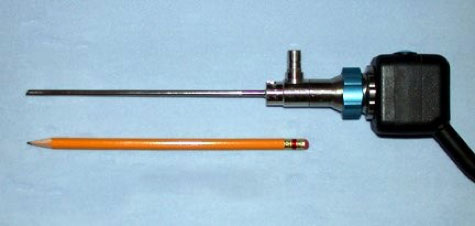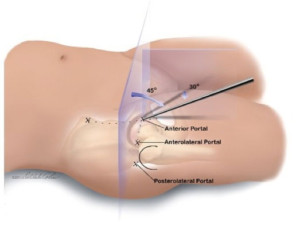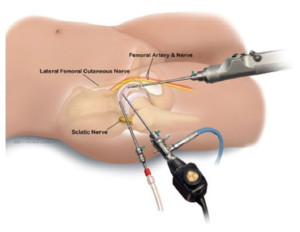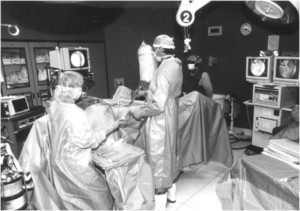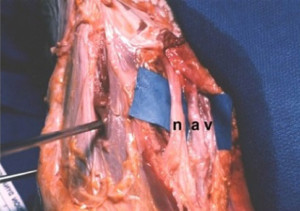Arthroscopy is the discipline of orthopaedic surgery dedicated to procedures performed with the aid of an arthroscope. The word arthroscope comes from the Greek word arthron, meaning joint, and skopéō, meaning instrument for viewing. Arthroscopic procedures are those performed on a joint. When the arthroscope is used as an adjunct to soft tissue procedures performed outside the joint, such as repairing torn tendons, this is more properly termed an endoscopic procedure. To learn more about the history of hip arthroscopy in Nashville, click here.
The arthroscope is a lens contained within a tube smaller than the diameter of a pencil with a camera attached to the end to view inside the joint and other structures. Arthroscopic surgery is performed with the arthroscope in conjunction with instruments placed through other small incision sites (portals) around the joint.
Arthroscopic surgery is commonly referred to as a minimally invasive procedure. Advantages compared to alternative conventional open methods are that the discomfort is much less with fewer major complications, and it allows for more effective postoperative rehabilitation. The success of any surgical procedure is very much dependent on the rehabilitation process following surgery, and this provides one of the biggest advantages of the arthroscopic surgery approach. However, any surgery is serious business, and while arthroscopic techniques are indeed much less invasive than traditional open operations, we are cautious to use the term minimally invasive.
It is only over the last two decades that arthroscopic surgery of the hip has become established. There are reasons that the hip lagged behind the knee and shoulder. First, the anatomy of the hip makes arthroscopy more technically challenging. The constrained architecture of the ball-and-socket joint limits maneuverability of instrumentation; the thick capsule requires more force to open the space for instrumentation; and the hip is also the most deeply situated joint in the body, encased within deep muscle layers.
Arthroscopic views of a normal hip joint.
Secondly, the evolution of hip arthroscopy (History of Hip Arthroscopy in Nashville) has been different than the knee and shoulder. Most procedures for these joints started with conventional open operations for types of damage that were well recognized and then evolved into less invasive arthroscopic approaches. Most hip problems benefiting from arthroscopy evolved from no treatment at all. In the past, these hip joint disorders went unrecognized and untreated, with patients simply resigned to living within the constraints of their symptoms. It was only once surgeons started looking in the hip that many of these problems, especially labral tears and articular cartilage damage, were recognized. In the past, large open operations were rarely performed for these poorly explained sources of pain. Once the existence of these problems was better appreciated by the arthroscope, more advanced methods began to be developed, addressing and correcting many of these disorders.
In 1994 Dr. Byrd first published the Supine Technique for performing Hip Arthroscopy (Related Study: Hip Arthroscopy Utilizing the Supine Position), which has become the most commonly used method around the world.
In 1995 Dr. Byrd described the anatomic relationship of the arthroscopy portals around the hip (Related Study: Hip Arthroscopy: An Anatomic Study of Portal Placement and Relationship to the Extra-Articular Structures), in the first scientific paper on Hip Arthroscopy ever presented at the American Academy of Orthopaedic Surgeons (AAOS) Annual meeting.
Not everything can be solved with arthroscopic surgery. Arthroscopy is simply one very useful tool among all of the options available to assess, treat, and correct a very broad spectrum of problems around the hip and pelvis. It is not a matter of what is the most appealing approach, but what is the best strategy to assure a successful outcome for each individual.
This Video illustrates the details of an entire arthroscopic Hip procedure.
Location
2004 Hayes Street
Suite 700
Nashville, TN 37203
Office Hours
Monday-Friday:
8:00 am – 5:00 pm
